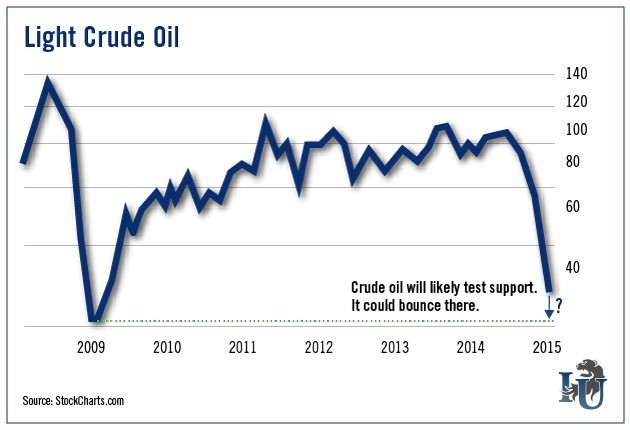Why oil is more likely to test $50 than $100 again next year
Post on: 16 Март, 2015 No Comment

Heinz-Peter Bader | Reuters
Saudi Arabian Oil Minister Ali al-Naimi.
When oil and gasoline prices are soaring, oil analysts like myself try to assuage the fears of consumers with the old saw: There is no better cure for high prices than high prices.
The succinct analysis of commodity market dynamics likely makes motorists irate, as they pay $100 or more to fill up the family SUV. They fail to appreciate how efficient market forces can be, even at that particular moment of pain.
However, that i s precisely why oil prices are falling now — and will likely continue to fall in the coming months to as low as $50 per barrel!
On Thursday, in its weekly inventory report, the U.S. Department of Energy reported that oil production in the United States rose to its highest level in 29 years to just over 9 million barrels per day. To put that in perspective, the U.S. is now nipping at Saudi Arabia’s heels, with that country currently producing about 9.6 million barrels per day.
The surge in U.S. oil production is due to the immense success of a reborn technology: hydraulic fracturing (better known as fracking), which has liberated millions of barrels of oil and millions of cubic feet of natural gas from fields that were thought to be bereft of fossil fuels.
Opponents of the practice have their work cut for them given the tremendous impact the drilling is having on oil and natural gas prices.
The second part of the low oil price story involves several key pipeline upgrades that actually changed the flow of oil, bringing it from the middle of the country to the Gulf Coast, where it is needed to supply the majority of the country’s refineries.
The changes have been so impactful that, at times, Gulf Coast storage facilities have been nearly filled to capacity. The U.S. has virtually ended imports of crude oil from West African countries, such as Nigeria, which used to be a key source of supply.
OPEC members are now scrambling to prop up oil prices, and find buyers for their oil. During the past several months, tankers of oil have sat idling, waiting to sail to port to unload their cargo. Saudi Arabia, Kuwait and Iran are in a battle to secure sales to China and other Asian buyers at the expense of other countries in the cartel.
It is not helping their cause that Alaska North Slope crude oil is now being exported to South Korea on a regular basis now. That started in September.
Adding to the supply glut has been the return of Libya’s oil production, despite a raging civil war with two competing governments asserting governance over the country. Also, even as ISIS forces roll through Iraq, exports continue to rise to record post-Iraq war levels.
The Kurds were finally able to strike a deal with Baghdad that will allow exports from Northern Iraq to surge, as well, in the coming months. If that’s not enough, North Sea production is set to rise over 11 percent in December, due to upgrades to the system there.
In other words, increasing amounts of crude oil are hitting the global market, left, right, and center.
Several OPEC members are now calling for a production cut to be announced at their upcoming meeting, but they are looking for Saudi Arabia to carry the load, which is not going to happen. Based upon bewildering statements by the Saudi oil minister this week, the Saudis do not appear inclined to cut.
Market share is more important to them because they want to maintain their relevance. With their low cost of production, they believe they can sweat out the higher-cost competition, including U.S. frackers.
So, the OPEC meeting on Thanksgiving Day will likely end in discord and cause another leg lower for oil prices.
By next March, U.S. oil production will be nearing the 9.5 million barrel per day level, and possibly higher. With the winter coming to an end then, the global market enters a slack demand period, which will increase the downward pressure on prices.
Oil producers of all stripes will be staring down prices near the $50 level. Russia’s President Putin is already preparing for a catastrophic oil price drop.
Something will have to give. Saudi Arabia and other OPEC members will be forced to curtail production or U.S. oil producers will have to throw in the towel as they await a price rebound. The U.S. needs to be careful what it wishes for, in terms of setting back the march toward energy independence.
The surging production trends will have consequences, in addition to the huge benefit to consumers. After all, as the saying goes, there is no better cure for low prices than low prices.
—John Kilduff is a partner at Again Capital, an investment management firm that specializes in commodities.














